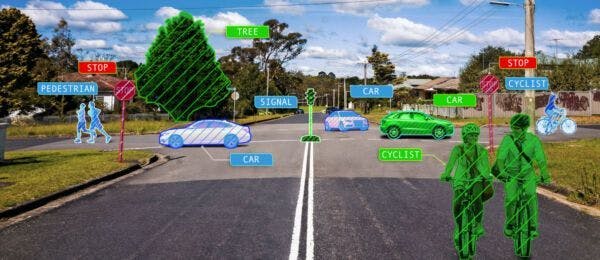In computer vision, instance segmentation refers to the identification and delineation of individual objects in an image or a video. Through the combination of object detection and semantic segmentation, a more detailed understanding of the visual scene can be gained.
Instance segmentation involves generating pixel-level masks for each instance of an object within an image. Instance segmentation differs from semantic segmentation in that each discrete instance of an object is given a unique label.
Instance segmentation generates a set of masks, each corresponding to an individual instance of an object. These masks enable the precise localization and segmentation of each individual object based on its boundaries.
Convolutional neural networks (CNNs) are commonly used for instance segmentation. A model is trained on annotated data containing masks corresponding to each instance of the object. By analyzing the training data and extracting patterns and features, the model is able to identify and segment objects.
In addition to autonomous driving, robotics, medical imaging, surveillance, augmented reality, and many others, it is possible to segment instances across several domains. Due to this, robotics and computer vision systems are capable of performing tasks such as counting objects, tracking objects, analyzing fine-grained objects, and comprehending scenes with great accuracy.
Segmentation of instances is essential for achieving precise object localization in the robotics industry.
Robotics applications benefit from instance segmentation in the following ways:
- A robotic system can precisely locate and manipulate specific objects with the assistance of instance segmentation. A robot must be able to recognize and grasp objects in cluttered environments as part of robotic pick-and-place operations.
-
It is possible to detect and avoid obstacles within an environment using instance segmentation. In navigation, robots can enhance their safety and efficiency by accurately locating objects and avoiding collisions.
-
It is possible for robots to track objects over time by applying instance segmentation over consecutive frames. As a result, robots will be able to track and follow moving objects, such as humans, animals, and vehicles, which is useful in situations where robots must interact with moving objects.
-
An improved understanding of the scene can be achieved through instance segmentation, by providing a detailed representation of objects and their relationships in the scene. A robot's environment can be mapped using this information in an accurate and up-to-date manner. Based on the objects in their surroundings, it allows robots to navigate autonomously, plan optimal paths, and make informed decisions.
-
The use of instance segmentation allows robots to recognize and classify different objects within their surroundings. Objects must be accurately localized and object-specific features must be extracted in order for robots to identify and interact with them.
As a result of instance segmentation, robots are able to recognize gestures, actions, and objects of interest, which facilitates human-robot interaction. It will be possible for a robot to perform these tasks more effectively if it is capable of working collaboratively and assisting humans in a variety of situations.
In industrial settings, automation is possible through the use of instance segmentation to identify and locate specific objects or parts. Robots are capable of performing tasks such as assembly, quality control, and inventory management based on the accurate localization of objects.
Final Thought
Through instance segmentation, robotics is able to improve the ability to perceive objects, navigate, manipulate, and interact with them. By implementing this technology, robotic systems will be safer, more efficient, and autonomous in a wide variety of applications. It is expected that instance segmentation will continue to advance in the robotics industry and beyond, making robots capable of performing complex tasks in a broad range of environments in the future.


